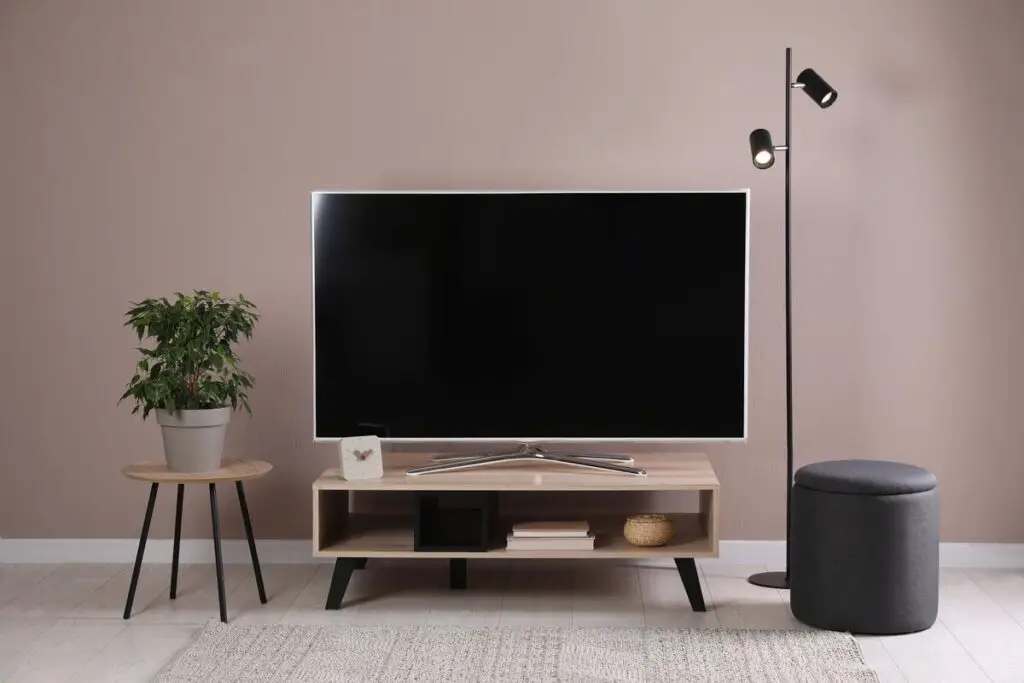Do Smart TVs Have Speakers? (Explained For Beginners)
Disclosure: Tech Parasol is supported by its readers. When you purchase through links on our site, we may earn an affiliate commission. Thank you.
- Most Smart TVs have two small built-in speakers, either at the bottom or on the back of the TV.
- Smart TV speakers don’t produce great quality sound by themselves.
- It is possible to connect additional external speakers to a Smart TV to enhance the sound produced by the TV.
When you buy a new TV, the main concern is the picture quality, but sound quality is also an important factor.
So you may be wondering whether Smart TVs have built-in speakers or whether you need to buy external speakers.
Do Smart TVs have built-in speakers?
Smart TVs generally have two small built-in speakers with a total output of 20W. The size and location of the speakers means that the sound is often lower quality compared to an external soundbar or audio system.

Are Smart TV speakers any good?
The speakers that are built into Smart TVs are okay for basic TV watching but aren’t very good for watching movies or listening to music.
Since smart TVs have gotten thinner over the years, there’s now less room for speakers than in previous years.
So the speakers themselves have gotten smaller which means the quality of the sound they produce has suffered as a result.
Speakers also need plenty of space to push the air around to make a decent sound.
But because the space is limited in TVs, the sound ends up becoming a bit lifeless to say the least.
Where are the speakers on a flat screen TV?
The speakers on a flat screen TV are either on the bottom or at the back of the TV.
If the speakers are on the bottom, make sure to prop up the TV using a stand or wall mount.
If the speakers are on the back, make sure the TV is away from the wall.
This will ensure that the sound isn’t muffled.
How many speakers do Smart TVs have?
TVs generally only have two small speakers with about 20W of total power.
Do Smart TVs have surround sound?
Most Smart TVs don’t have surround sound because there isn’t room inside the TV for all the additional channels.
That being said, the Panasonic JZ2000 is an exception. The sound system in this particular TV rivals most soundbars.
Smart TVs are also able to recognize surround sound input and send it to an amplifier or receiver which can then transmit the sound to the speakers.
Do they sell TVs without speakers?
All TVs come with speakers, but some TVs are sold without speakers in the traditional sense.
For example, some LG TVs have Crystal Sound OLED technology that can make sound by vibrating the screen.
Do I need a soundbar with a Smart TV?
It’s not necessary to have a Soundbar with a Smart TV, but it is recommended as they produce much better audio than built-in speakers.
Soundbars produce much better sound than TV speakers because they contain more speakers and have larger, higher quality drivers.
Soundbars are also useful if you have limited inputs on your TV. Most soundbars offer HDMI inputs so you connect additional devices.
Is a soundbar better than TV speakers?
Soundbars are significantly better than TV speakers and often contain more speakers and have higher quality drivers.
Even the most basic soundbar models tend to have more power output than built-in speakers.
This means that you can play the audio louder without distortion or loss of clarity and they project the sound towards you.
Soundbars generally come with a subwoofer too.
These are large speakers that can produce deep bass sounds that built-in TV speakers would never be able to compete with.
These speakers can make movies more exciting especially when you’re watching one that has lots of booms and explosions!
Subwoofers can also make dialog easier to hear by taking the low tones away from the smaller speakers.
This allows the smaller speakers to be dedicated to the mid and high range sounds that dialog normally falls into.
Does a soundbar replace TV speakers?
Soundbars are designed to replace TV speakers though some TVs do allow you to use the soundbar and the built-in speakers simultaneously.
TV speakers generally don’t do anything to improve the quality of the sound. So it’s best to disable the TV speakers.
Can you use built-in speakers with a Soundbar?
You can use built-in speakers with a soundbar but it’s best to disable them.
The main reason is that the audio produced by the soundbar won’t be in-sync with the audio produced by the TV’s speakers.
So you will hear the same sound from two different sources but with a little delay between the two. This produces an echo.
Also TV speakers are likely to detract from the sound quality produced by the soundbar.
Can I connect external speakers to my Smart TV?
You can only connect external speakers directly to a Smart TV if the speakers are “active” and contain an amplifier (e.g. a soundbar or powered computer speakers).
Here are the options when it comes to connecting external speakers to a Smart TV:
- RCA
- Digital Optical
- 3.5mm analog cables
- HDMI-ARC
- Bluetooth
- WISA
RCA
You can plug an RCA cable into the RCA outputs on a TV and connect them directly into the analog audio inputs on a soundbar or powered speakers.
To connect passive speakers to a TV, you can connect them to a TV but they must go via an amplifier or a receiver.
Digital Optical
Digital Optical is a better option to send audio from your TV to external speakers.
If you want to connect a soundbar, then you connect the TV directly to it using a digital optical cable.
However, to connect your TV to external speakers via digital optical, you’ll need an amplifier or a receiver in-between the TV and the speakers.
3.5mm analog cables
It is possible to connect a TV directly to powered speakers via 3.5mm analog cables.
But again, for passive speakers, you’ll need to use an amplifier or receiver in order to power the speakers.
HDMI-ARC
You can connect a TV to an external audio system via HDMI ARC if the TV and the soundbar or receiver has a dedicated HDMI-ARC port.
HDMI-ARC receives video and audio signals like regular HDMI, but it is also capable of transmitting audio signals to a soundbar or sound system.
This eliminates the need for an additional cable between the TV and the sound system.
Bluetooth
Another way to connect a TV is via Bluetooth. The obvious benefit of this is that it’s a wireless solution.
But most TVs don’t have this capability and are mainly offered by Samsung and LG TVs.
WiSA
One final way to connect a TV to speakers is using WiSA (Wireless Speaker and Audio Association).
WiSA is a wireless hardware and software standard that allows devices to transmit high resolution digital audio wirelessly from a source device to up to 8 channels.
This completely eliminates the need for speaker wire.
For WiSA to work, you need a WiSA compatible TV like the LG C9 which has the necessary software already installed.
But TVs don’t yet contain WiSA transmitters, so you would need to buy one separately like the Axiim Link HD transmitter.
Once the transmitter is installed, you’re then able to control the speakers wirelessly using the on-screen interface on the TV.
Do LED TVs have speakers?
LED TVs typically have two built-in speakers.
Do Frame TVs have speakers?
Frame TVs do have speakers, some of which produce good, balanced sound and clear dialogue.
But the sound can distort at higher volumes
Do Samsung TVs have speakers?
Samsung Smart TVs have built-in speakers.
On newer Samsung TVs, you can get the best sound out of the TV speakers by using optimized sound modes and adjusting expert sound settings.
Expert sound settings can be found by pressing the home button and navigating to settings -> sound -> expert settings.
Sources
How to Connect Your TV to an External Audio System

Robert Anderson
Robert Anderson, the founder of Tech Parasol, had a keen interest in tech from a very young age. He studied Electronic Engineering at University and then went on to become a Software Developer. He launched Tech Parasol in 2021 to share his knowledge with the aim of making tech easier to understand for everyone.

